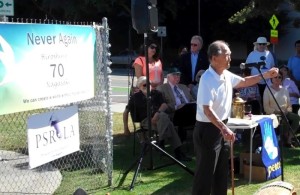
News & Analysis
11:01 am Nagasaki Japan August 9, 1945
Forty seven seconds into this fateful minute, the Fat Man atomic bomb detonated just over 1,600 feet above a Nagasaki tennis court. The last thing the players would have seen was the shiny Silverplate B-29 Bockscar U.S. bomber hightailing it away from its deadly cargo before it blew up.
A flash brighter than the sun rendered the sky with 7,050 degree Fahrenheit winds roaring at 624 miles per hour. The equivalent of 21 kilotons of TNT ignited above the city for maximum effect, destroying 44 percent of it instantaneously.
In that spit-second instant, about half of those killed in Nagasaki – at least 80,000 – were incinerated. Another 60,000 lay gravely injured.
“Very large numbers of person were crushed in their homes and in the buildings in which they were working,” according to the Children of the Atomic Bomb website developed by Dr. James N. Yamazaki, UCLA professor emeritus of pediatrics, together with the UCLA Asian American Studies Center. “Their skeletons could be seen in the debris and ashes for almost 1,500 meters from the center of the blast, particularly in the downwind directions.”
“Large numbers of the population walked for considerable distances after the detonation before they collapsed and died,” continues Yamazaki. “Large numbers developed vomiting and bloody and watery diarrhea (vomitus and bloody feces were found on the floor in many of the aid stations), associated with extreme weakness. They died in the first and second weeks after the bombs were dropped. During this same period deaths from internal injuries and from burns were common.”
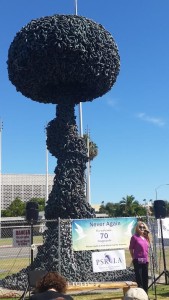 4:15 pm Santa Monica California August 5, 2015
4:15 pm Santa Monica California August 5, 2015
Three days prior to Nagasaki’s destruction, the atomic bomb Little Boy blew up over Hiroshima. Exactly 70 years to the minute, over 200 people gathered for a moment of silence and testimonials in the shadow of Chain Reaction, a 26-foot high sculpture of a nuclear explosion made out of chain links in Santa Monica. The sculpture was designed by Pulitzer-prize winning political cartoonist Paul Conrad, whose son Dave was present for the Never Again – Hiroshima and Nagasaki 70th Anniversary Commemoration organized by Physicians for Social Responsibility – Los Angeles (PSR-LA).
The Hiroshima Peace Flame, brought to Los Angeles in 1989 by then Mayor Tom Bradley, flickered in the light Pacific breeze on a nearby table. The Reverend Ryuzen Hayashi of the Koyasan Buddhist Temple tolled a doleful bell seven times to mark the decades the exact moment the bomb exploded over Hiroshima. Attendees then somberly held a moment of silence for all who perished.
According to the papers of then-President Harry S Truman, the Hiroshima blast immediately killed 30 percent of the city’s 340,000 people. Over 102,000 men, women and children being obliterated, vaporized, crushed, burned and sliced to death from a tornado of broken glass.
Many more would die in hideous ways. Others, like 16 year old Junji Sarashina, managed to survive even as their world was blown apart in a radioactive firestorm.
Now 86 and living in Buena Park, the Hawaiian-born Sarashina is one of the hibakusha, the Japanese word for “explosion-affected people” who survived Hiroshima or Nagasaki or both as over 160 people did. Sarashina is a member of the American Society of Hiroshima-Nagasaki A-Bomb Survivors, several of whom attended the Santa Monica event.
This reporter first met Sarashina at a Hiroshima commemoration three days earlier at the Koyasan Buddhist Temple in Little Tokyo. Along the walls of the temple were large black and white photographs of the destroyed city, as well as Nagasaki, along with countless burned and vaporized bodies. I struck up a conversation with a Japanese man who said his name was Hector, also looking at the gruesome and astonishing images.
“Do you think the United States needed to do this?” Hector asked me. I replied that I didn’t and cited what then-Supreme Commander of the Allied Forces in Europe, General Dwight D. Eisenhower told Newsweek after he was President in 1963.
“I was against it on two counts,” Eisenhower said. “First, the Japanese were ready to surrender, and it wasn’t necessary to hit them with that awful thing. Second, I hated to see our country be the first to use such a weapon.”
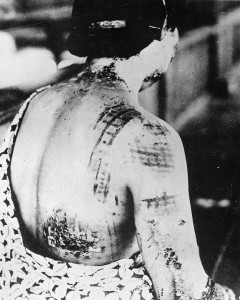
Sarashina was toiling at a factory two miles from the hypocenter of the Hiroshima atomic bomb when it shattered the city. A brick wall fell on him as he was knocked to the ground, saving him in the process.
“I was 16 years old when the bomb was dropped on Hiroshima,” Sarashina told the hushed crowd as television crews and news photographers recorded the scene. “The bomb was dropped with the orange flash. I was flat on the ground, knocked down on the ground. The building collapsed and blood was flying.
“I couldn’t see a thing. I couldn’t hear anything. I thought I was a dead dog. Somehow, I realized that I’m still alive. I was covered with a thousand pieces of glass, broken glass and yet I didn’t have a scratch on my body. First thing that came to my mind is I have to go to the first aid station to see what they can do for me. I walked to the first aid station and the nurse standing there, in the white clothes, covered with blood, I couldn’t even recognize her face. Shrapnel from the broken glass covered her. She couldn’t speak. She opened her mouth and I pulled out about one inch square of broken glass and I just pulled the thing out of her mouth.”
After the tolling, Sarashina’s story continued. Even with all the films and photographs of the atomic bombings available to see, nothing is as chilling as hearing an account of an atomic atrocity coming from the mouth of someone who has lived to tell about it.
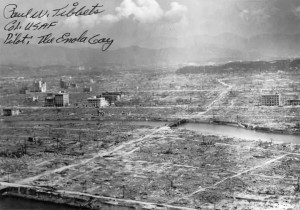 “I tried to enter the city of Hiroshima but I couldn’t [because] the whole city’s burning,” Sarashina softly said. “The following day, we were allowed to walk in to the city of Hiroshima. I went to the high school then but couldn’t find the school because it was flat, burned, everything ashes. At the school, there was a swimming pool. I tried to pull a kid out of the pool. The only thing I was able to pull out was his skin. It peeled all off. They were all burned.”
“I tried to enter the city of Hiroshima but I couldn’t [because] the whole city’s burning,” Sarashina softly said. “The following day, we were allowed to walk in to the city of Hiroshima. I went to the high school then but couldn’t find the school because it was flat, burned, everything ashes. At the school, there was a swimming pool. I tried to pull a kid out of the pool. The only thing I was able to pull out was his skin. It peeled all off. They were all burned.”
Sarashina was one of just ten students of his 250-person freshman high school class that wasn’t killed in the blast. He has carried that burden of being lucky that morning for 70 years yet has not hesitated to relieve the horrors in front of rapt audiences repeatedly in his quest for peace.
Following his remarks, June Kuramoto of the Asian-American jazz fusion band Hiroshima played a musical tribute of “Thousand Cranes” on her koto, a traditional Japanese stringed musical instrument. Dr. Jimmy Hara, Board Member of PSR-LA, told the story behind the song, of Sadako Sasaki, a young girl who died from leukemia caused by exposure to the bomb’s radiation. Sadako wanted to fold a thousand oragami paper cranes for good luck, but died before she finished. Her friends folded the remaining cranes which have stood as symbol for peace ever since.
Anti-nuclear and peace stalwarts including Blase Bonpane of the Office of the Americas, Alice Soto of Pax Christi and Stephen Rohde of the Interfaith Communities United for Justice and Peace, then gave impassioned speeches imploring the end to nuclear weapons worldwide. Newer voices were represented by Danny Hall of Soka Gakkai International USA, a Buddhist organization that has organized thousands of young people worldwide to oppose nuclear weapons.
The challenge is daunting, according to PSR-LA. There are 15,700 nukes in the world’s arsenal today, according to the Federation of American Scientists. About 1,800 U.S. and Russian warheads of these are on high alert, ready for use on a moment’s notice. Hacking their control systems is a real concern, and there have been many documented nuclear near-misses over the years caused by technical or communication problems.
“A recent report by IPPNW and PSR shows that even a very limited nuclear war, involving just 100 Hiroshima sized bombs – less than half a percent of the world’s nuclear arsenals – would disrupt climate and agriculture across the globe enough to produce a global famine that could kill 2 billion people,” stated PSR-LA’s Never Again press release. “Statisticians estimate a range between 10 – 30% chance of a nuclear war in the next ten years. The U.S. administration plans to spend $348 billion over the next 10 years and $1 trillion over the next 30 years to maintain and modernize the entire American nuclear arsenal.”
The outrage of further bankrupting the United States by maintaining and modernizing a weapons system this dangerous and unusable did not go unnoticed by the speakers. Of course, such a modernization program, even as astronomically high in cost as America’s, is based on the reckless notion that a nuclear war can be won.
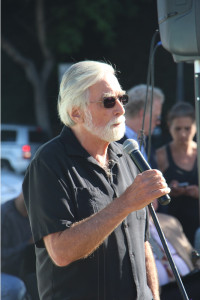
“And then I said, “What are you going to do with all these weapons? Why are you building more? What is this whole thing about?” He said “Well that question makes some sense if you don’t believe nuclear war is winnable.” And then he then outlined how nuclear war is winnable.
“This is not an idea that is old. This is an idea that had currency at that time because you’re not building these weapons without the idea that you can use them. Whether you’re Pakistan or Israel or any other government, you’re building these weapons because you think at some point, the taking of other people’s lives indiscriminately, civilians, is justified.
“Even Hillary Clinton said that if Iran were to attack Israel, the population would be obliterated. That is the language of genocide. That is the language of terror. It gives you the right to destroy men, women and children who are innocent, who have nothing to do with the war.”
Faced with such odds against nuclear abolition, it is nevertheless not a hopeless cause. Indeed, the Chain Reaction sculpture itself was saved from demolition by activists like Jerry Rubin, who was in the audience on a fast for peace, and Scheer, both of whom served on a successful committee to preserve the piece in 2014.
At the recent Nuclear Nonproliferation Treaty Review Conference in New York this past May, 159 nations – 82 percent of all countries – issued a Joint Statement demanding that the nuclear-armed countries totally eliminate their arsenals. Moreover, over 110 countries have signed the “Humanitarian Pledge” to support a legal ban on nuclear weapons.
With this momentum, and world leaders like Pope Francis, Bishop Desmond Tutu and United Nations Secretary General Ban Ki-Moon all calling for complete nuclear weapons abolition, the crowd at Never Again could afford some hope. Even bus drivers from buses idling on an adjacent street descended from their vehicles to hear the speakers, some visibly moved.
Nevertheless, not everyone in the audience bought onto the notion that nukes can actually be, well, nuked. One such person called himself Dale who brought his daughter from their home in Glendale to attend the event.
“We cannot change the past, nor can we change human nature,” Dale told me in an email afterwards. “It seemed that many of today’s speakers wished to change the minds of world leaders or awareness of young people.”
“I can only think of one or two things that atomic weapons are good for,” Dale wrote. “And, Bruce Willis deflecting a planet killing meteor is a bit of a stretch. Not entirely out of the realm of possibility, but not very likely. Still, we are the only life form that has evolved on Earth which has the ability to defend the planet from such a potential life-ending cosmic collision. If that event threatens to happen some day, and we prevent it from happening with atomics, were we simply destined to become something greater despite our horrible mistakes? Is there a silver lining to the dark clouds in the human psyche? If we can only focus on the mistakes of the past, are we missing what our true potential might be? It’s a hopeful positive use of an otherwise terrifying weapon. Now if we can just chase those dark clouds out of everyone’s mind, and put the mistakes of the past behind us, for good.”
If human nature can’t be changed, it is unlikely that the potential use of nuclear weapons to obliterate errant comets is going to make people forget those pesky “mistakes of the past” in order to realize their “true potential.” Nuclear weapons are not a psychological problem we need to think more positively about in order to keep us safe from comets. They are humanity’s gun pointed at its own head.
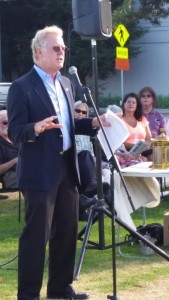
“We the people have allowed this to happen,” Dodge said, voice rising. “We the people have a responsibility to speak up and speak out and make sure that this does not happen.”
“You will do inconvenient things to get this done because for the last two hours we’ve had the luxury of sitting here by sheer luck that some cybersphere or accidental or deliberate attack has not happened,” Dodge said. “Luck is not a security policy. We must rise up and make sure this never happens again.”
The 70th anniversary of the atomic bombings of Hiroshima and Nagasaki have brought global attention to the nuclear threat for a few days. But it will take more than a few days to prevent that nanosecond when a nuclear weapon is set off anywhere in the world destroying any hope for humanity to rid us of this nuclear scourge.












“…we all remain hostage to nuclear threat that hangs over us every moment of every day as a consequence of the leadership void we face. Ultimately luck remains our security policy, hoping that nuclear war does not happen by accident, cyberattack or intent. ”
– Dr. Dodge Aug 8, 2015
Nuclear war or Nuclear Power Plant Meltdowns. 😐
Buddha – “…taught his followers not to believe in luck. He taught that all things which happen must have a cause, either material or spiritual, and do not occur due to luck, chance or fate…”
https://en.wikipedia.org/wiki/Luck
My experience is like Joan’s — I started having nightmares about nuclear wars when I was 15 or so, and they persisted until I was at least 30. Saber-rattling nitwits insist that we need these devices — what they really want is to be paid not to set them off.
Thanks again, Michael, for continuing to write such powerful pieces of journalism! We aren’t the insane ones (although I sometimes feel like it.)
Michael,
Excellent piece. The 70th anniversary of this hideous event got me thinking about Hiroshima again. My father, who was a career US Army guy, took my mother, sister and me to Hiroshima when we were living in Osaka. I would have been about five or six years old. A Catholic church wasn’t too far away from the actual target (a building with a dome on top, the steel structure of which was a ghastly reminder of what had happened). The parish priest took my sister and I up the stairs to the bell tower and we saw the naked dome of the building, which was still surrounded by a field of largely rubble. It was so horrific that I never forgot it, nor did my younger sister. I’m now 68 years old, but your piece took me right back to that painful day. I hope that something like this never happens again.
“Still, we are the only life form that has evolved on Earth which has the ability to defend the planet from such a potential life-ending cosmic collision.”
My take and rephrase,
Still, we are the only life form that has evolved on Earth which has the ability to destroy the planet by use of nuclear technology.
Using a nuclear bomb to destroy a meteorite is theatrical fantasy. It would potentially create a much bigger disaster, by breaking the meteorite into lots of smaller, radioactively contaminated meteorites, that would shower the earth. A better way would be to nudge it into a different orbit, by using a rocket on a meteorite lander, or a high powered laser etc.
Sometimes brute force is not a very intelligent way to deal with a problem.
Nuclear and fossil fuels are old and outdated technologies, dinosaurs of the past. We now have excellent safer, cheaper, more efficient environmentally friendly technologies for producing energy .
The obstacles to the full implementation of these clean technologies are world leaders and financiers, who are stuck in a mindset of greed and power, plus a docile populace.
I was born in 1953, one month after the executions of Cold War spies Julius and Ethel Rosenberg. I grew up terrified of a nuclear war. Unknown to me as a child, we lived about one mile from a Nike missile site. In high school, I had to drive through the missile site hidden in the small hills of a WPA water project. Twice a day. In college at Boulder, Colorado, I was informed (although I didn’t believe it then) that Boulder was sometimes downwind of the notorious Rocky Flats nuclear facility which was still emitting radiation, evidence of the failure of workers to control it. Well into my adult years, I first learned that a family who lived nearby and were held in very high esteem by my family, had regular meetings at their house. They were Communists. I lived in an extremely conservative area which had more than its share of influence due to a disproportional number of residents became national leaders (yes, even Chicago Mayor Rahm Emanuel). Rumsfeld got his start in Congress from our congressional district.
I mention this because my own parents, who knew all about the meetings and politics of these neighbors, never once mentioned it to me. Not our business, they said later. These neighbors became good friends.
There I was, so afraid of nuclear weapons that any siren would make my blood freeze. And there they were, the so-called enemy, Communists, right outside our front door.
In 1985, I attended the first Los Angeles meeting of a group that wanted to end the nuclear arms race. I left that meeting thinking those people were nut jobs. Holding hands and singing Kumbaya seemed to alleviate the guilt of too many. Holy cow, nothing of substance will ever be done to stop the nuclear arms buildup.
By 1986, I had been proven wrong. This seemingly lightweight group’s mission of halting the very defense systems of two deeply established enemies had transmuted into a powerful grassroots movement. The arms race stopped. Treaties were signed. The master nuclear war clock, for the first time, ticked backwards, indicating a smaller chance of total nuclear war. All because some people got together and decided to make the insanity stop.
Long story but I am supporting this movement. I know it can be successful, albeit great difficulties must be overcome. It may have taken a personality change from pragmatic to optimistic on my part, but I believe it really can work.
Thank you to everyone who is doing the work to make it better for all of us. Michael, this piece is beautifully written. You had me deeply involved and your descriptions of the horrific effects of the first little, adorable, baby atomic bombs are unforgettable. Your work in this area is crucial. Your dedication to this work is awesome, buddy. Because of you, I know more and fear less. It is empowering.
Joan
Great article! A bit squeamish for me in parts but it is reality and not a movie. Good on ya Michael! Must have been a powerful gathering! Thanks, Lorraine Scott